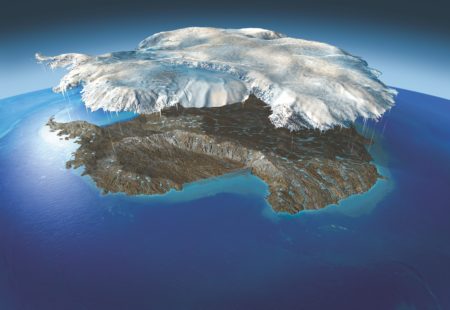What’s beneath Antarctica’s ice?
Antarctica, Earth’s fifth-largest continent, has scenery as dramatic as America’s Great Lakes or the European Alps, yet its mountains and lakes are as unexplored as Mars. Ice sheets around 1.6 kilometres (one mile) thick have buried 98 per cent of the continent for more than 25 million years; the weight of ice depresses the ground (600 metres) 2,000 feet in places.
The continent began to freeze over around 34 million years ago when levels of carbon dioxide – a gas that contributes to global warming – plummeted. Antarctica’s climate cooled and snow failed to melt on the Gamburtsev mountain range. Over thousands of years, fresh snowfall crushed air from the snow, squishing it into dense ice. The ice moved downhill under its own weight as glaciers, and then these grew and merged into gigantic ice sheets.
HUNDREDS OF LAKES
Around 400 lakes exist beneath Antarctica’s ice sheets, many kilometres long. Among them is Lake Vostok, one of Earth’s biggest freshwater lakes. The water remains liquid beneath kilometres of ice because it’s warmed by heat from the Earth’s interior. The ice above the lake acts as an enormous insulating blanket.
BURIED VOLCANOES
Western Antarctica contains a rift system similar in length to the East African Rift where Earth’s crust is moving apart. Hot rock rises into the gap to create volcanoes. Heat from an under-ice eruption 2,000 years ago may have accelerated Pine Island Glacier, one of Antarctica’s biggest and fastest ice streams.
A RIFT VALLEY

With the ice cap raised, we see the features that form the Antarctic Peninsula at the top left, the Ross Ice Shelf in the centre, the Transantarctic Mountains on the right of the Ross Ice Shelf, and the high plateaus of East Antarctica.
The eastern and western halves of Antarctica are splitting apart. As they separate, blocks of the Earth’s crust drop downwards to create narrow, steep-sided canyons. A rift valley beneath the Ferrigno Ice Stream is channelling warm seawater 100km (62mi) inland, hastening melting of the ice sheet.
A HIDDEN MOUNTAIN RANGE
The peaks of Antarctica’s Transantarctic Mountains poke from the ice, but the Gamburtsev mountain range is completely buried. Both ranges formed by rifting, which occurs when sections of the Earth’s crust pull apart. The crust stretches, warms, forms a dome and eventually breaks apart. The dome’s edges then bounce up, forming mountains.
A RIVER AS BIG AS THE THAMES
Antarctica’s hidden lakes may share water via massive flood channels the size of London’s Thames. Water pressure increases until the lake flushes like a toilet. In the biggest recorded flood, 6.4km3 (1.5mi3) of lake water drained into the Southern Ocean; that’s a volume equivalent to Scotland’s Loch Ness.
EXTREME LIFE FORMS
Lakes deep beneath Antarctica’s ice are among Earth’s most extreme environments. Bacteria and single-celled organisms discovered in Lake Whillans survive intense pressures, temperatures of -0.5°C (31°F), eternal darkness and have little connection to the surface. Scientists believe they eat rock minerals like sulphur and iron, and may live nowhere else on the planet.
The ice in Antarctica’s interior is frozen to the bedrock and moves at a mere two metres (6.6 feet) per year. Near the coast, water and soft flexible sediment lubricate the ice to form fast-moving channels called ice streams. They comprise only ten per cent of ice sheet volume, but carry most of the continent’s inland ice to the coast like gigantic conveyor belts.
When the ice reaches the sea, it floats because it is less dense than water. If the ice is thick and fast-moving enough, it spreads into a permanent floating platform. These ice shelves fringe the continent, some with an area bigger than the British Isles. When the ice shelves meet warm seawater, they melt, with chunks breaking off to form icebergs.
Climate change is melting Antarctica’s ice shelves and accelerating its ice streams. The Pine Island Glacier slid into the sea ten per cent faster during the Nineties, while its ice shelf is now melting 50 per cent faster than in the Nineties. The total collapse of this glacier could raise the global sea level by around 24 centimetres (9.4 inches).
For more science and technology articles, pick up the latest copy of How It Works from all good retailers or from our website now. If you have a tablet or smartphone, you can also download the digital version onto your iOS or Android device. To make sure you never miss an issue of How It Works magazine, subscribe today!





